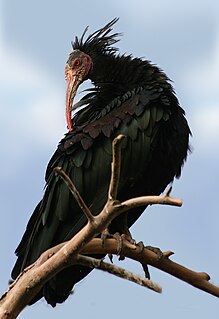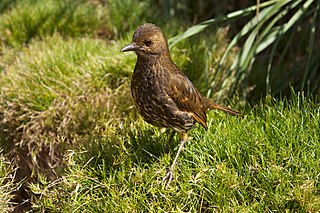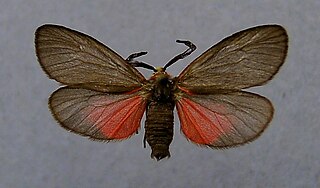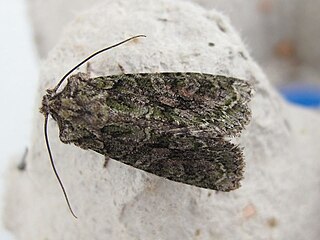
The northern bald ibis, hermit ibis, or waldrapp is a migratory bird found in barren, semi-desert or rocky habitats, often close to running water. This 70–80 cm (28–31 in) glossy black ibis, which, unlike many members of the ibis family, is non-wading, has an unfeathered red face and head, and a long, curved red bill. It breeds colonially on coastal or mountain cliff ledges, where it typically lays two to three eggs in a stick nest, and feeds on lizards, insects, and other small animals.
The Heterogynidae are a family of insects in the order Lepidoptera. Only two genera are currently recognized: Heterogynis and Janseola.
Cecidosidae is a family of primitive monotrysian moths in the order Lepidoptera which have a piercing ovipositor used for laying eggs in plant tissue in which they induce galls, or they mine in bark. Nine species occur in southern Africa, five species in South America and Xanadoses nielseni was recently described from New Zealand. Some minute parasitoid wasps are known.

The Tristan thrush, also known as the starchy, is a species of bird in the thrush family that is endemic to the British overseas territories of the isolated Tristan da Cunha archipelago in the South Atlantic Ocean.
Cecidoses is a genus of moth in the family Cecidosidae.

Aglaope infausta is a moth of the family Zygaenidae.
Hadjina is a genus of moths of the family Noctuidae. The genus was described by Staudinger in 1891.
Syngatha is a genus of moths of the family Noctuidae. The genus was erected by George Thomas Bethune-Baker in 1913.

Dryobotodes eremita, the brindled green, is a moth of the family Noctuidae. The species was first described by Johan Christian Fabricius in 1775. It is found in most of Europe, east to Turkey.
Heterogynis is a genus of moths of the Heterogynidae family.
Cecidoses eremita is a moth of the family Cecidosidae. It was described by John Curtis in 1835. It is found in South America, including Uruguay and Argentina.
Amselina eremita is a moth in the family Autostichidae. It was described by László Anthony Gozmány in 1963. It is found in Iran.
Heterogynis canalensis is a moth in the Heterogynidae family. It was described by Thomas Algernon Chapman in 1904. The Global Lepidoptera Names Index reports it as a synonym of Heterogynis penella.
Heterogynis paradoxa is a moth in the Heterogynidae family. It was described by Jules Pierre Rambur in 1837.
Heterogynis andalusica is a moth in the Heterogynidae family. It was described by Franz Daniel in 1966.
Heterogynis thomas is a moth in the Heterogynidae family. It was described by Alberto Zilli in 1987.
Heterogynis jellaba is a moth in the Heterogynidae family. It was described by Josef J. de Freina in 2003.
Heterogynis rifensis is a moth in the Heterogynidae family. It was described by Josef J. de Freina in 2003.
Janseola is a genus of moths in the family Heterogynidae. It was described by Walter Hopp in 1923
Janseola eremita is a moth in the family Heterogynidae. It was described by Alberto Zilli and colleagues in 1988.



